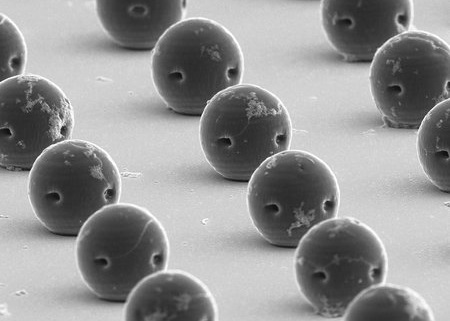Ultrasound Imaging-Guided Miniature Robots Enable Targeted Drug Delivery Directly to Tumor Site
Posted on 12 Dec 2024
In the future, miniature robots may be tasked with delivering therapeutic drugs directly to targeted areas within the body. Instead of the traditional metal humanoid robots, they would be in the form of tiny, bubble-like spheres. Such robots would need to meet several stringent requirements, including surviving in bodily fluids like stomach acid, being controllable to direct them precisely to the target area, releasing their medicinal contents only upon reaching the target, and being absorbable without causing harm. Now, researchers have developed bioresorbable acoustic microrobots (BAM) that meet all of these criteria and have been shown to deliver therapeutics to reduce bladder tumor sizes in mice.
Micro- and nanorobots have been in development for two decades, but their practical application in living systems has been limited. The challenge has been the difficulty of moving objects with precision in complex biological fluids such as blood, urine, or saliva. Additionally, these robots must be biocompatible and bioresorbable, meaning they must not leave behind any toxic materials. The new microrobots, developed by researchers from the California Institute of Technology (Pasadena, CA, USA), are spherical microstructures made from a hydrogel called poly(ethylene glycol) diacrylate. Hydrogels are materials that start in a liquid or resin form but solidify once the polymers inside them cross-link, making them ideal for retaining fluids and being biocompatible. The manufacturing method for these microrobots allows the outer spheres to carry therapeutic drugs to target sites in the body.

To create these microrobots, the team utilized two-photon polymerization (TPP) lithography, a precise technique that uses infrared laser pulses to cross-link photosensitive polymers into a specific pattern. This allows the microrobots to be constructed with remarkable precision, layer by layer, similar to a 3D printing process but with much finer detail. The resulting microrobots are about 30 microns in diameter, roughly the size of a human hair, and contain magnetic nanoparticles along with the therapeutic drug within their spherical structure. These magnetic nanoparticles enable the microrobots to be directed by an external magnetic field, allowing them to reach their desired location. Upon arrival, the robots remain in place while the drug is passively released, as described in the journal Science Robotics.
The exterior of the microrobot is hydrophilic (water-attracting), ensuring that the robots do not clump together as they move through the body. However, the interior must be hydrophobic (water-repelling) to trap an air bubble, essential for movement. To achieve this, the team developed a two-step chemical modification. First, they attached long-chain carbon molecules to the hydrogel, making the entire structure hydrophobic. Then, they used oxygen plasma etching to remove the carbon chains from the interior, leaving it hydrophilic while maintaining the hydrophobic exterior. This modification enabled the robots to trap bubbles for longer durations, ranging from several days instead of the few minutes they would typically last. The bubbles are crucial for both movement and real-time imaging. The robots have two cylindrical openings—one at the top and another on the side. The research team found that the use of two openings gave the robots the ability to move not only in various viscous biofluids, but also at greater speeds than can be achieved with a single opening.
The team developed a way to track the microrobots as they move to their targets with the help of ultrasound imaging. Trapped within each microstructure is an egg-like bubble that serves as an excellent ultrasound imaging contrast agent, enabling real-time monitoring of the bots in vivo. When exposed to an ultrasound field, the bubbles vibrate, creating a flow of fluid that propels the robots. The team tested the microrobots as a drug-delivery tool in mice with bladder tumors. The results showed that administering therapeutics using the microrobots was more effective at shrinking tumors compared to traditional drug delivery methods. Over 21 days, four doses of therapeutic drugs delivered by the microrobots resulted in greater tumor reduction, demonstrating the potential of this technology for future therapeutic applications.
"We think this is a very promising platform for drug delivery and precision surgery," said Wei Gao, professor of medical engineering at Caltech. "Looking to the future, we could evaluate using this robot as a platform to deliver different types of therapeutic payloads or agents for different conditions. And in the long term, we hope to test this in humans."














